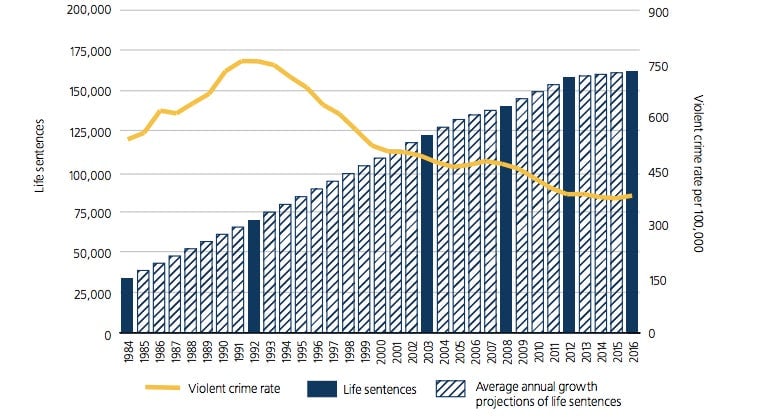One in three prisoners serving a life term anywhere is in the US
The massive US prison population has started to fall in recent years, with violent crime at historic lows. Despite this, the number of inmates locked up for life is at an all-time high, according to a new report.


The massive US prison population has started to fall in recent years, with violent crime at historic lows. Despite this, the number of inmates locked up for life is at an all-time high, according to a new report.
One in seven US prisoners is serving an actual or de-facto life term. And those serving life sentences in the US account for nearly a third of all life prisoners around the world. That’s more than 160,000 out of an estimated 536,000 worldwide.

A perhaps even more striking data point? The rate at which the United States sentences people to life—50 out of 100,000 people in the overall population—is nearly equivalent to the incarceration rates for all crimes in Denmark, Sweden, and Finland.
The new report from the Sentencing Project adds a category to the way life-sentence statistics are usually reported. In addition to life sentences with parole and without parole, they added the “virtual” life sentence, which refers to “a term of imprisonment that a person is unlikely to survive if carried out in full.” The authors establish the cut-off at 50 years or longer (which include sentences as long as 750 years, still not technically considered “life” by courts). There are 44,311 inmates serving such terms in the US, part of a total of more than 206,000 sentenced for life.
It is important to note that life sentences often don’t always mean “life,” criminologist John Pfaff points out— in fact, they are often much, much shorter.
But the fact remains that the US sentences tens of thousands to decades in prison—these numbers have more than quadrupled since the 1980s, even as crime declined—and that the system is rife with unfairness.
As elsewhere in the criminal justice system, people of color are disproportionately sentenced to life terms. Nearly half of the population with life, or “virtual” life sentences, are African-American.
A staggering number of those serving life in the US were sentenced as juveniles: 12,000. More than 2,300 of them received terms of life without parole—a sentence that human-rights groups believe is only handed out in the United States.
There’s a broader reason why this matters. The majority of inmates serving life sentences in the three categories outlined by The Sentencing Project have been convicted of violent crimes (although a whopping 17,000 are serving life for non-violent crimes).
In order to effectively reduce America’s prison population—a goal for both the left and the right—addressing the way violent crime is punished should be on top of politicians’ agenda. Inmates convicted for violent crimes account for a huge chunk of the locked-up population: more than half of inmates in state prisons.
As authors of the project note, long sentences are far from the optimal way to combat crime. “The impulse to engage in crime, including violent crime, is highly correlated with age, and by one’s early 40s even those identified as the most chronic ‘career criminals’ have tapered off considerably,” they write.